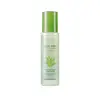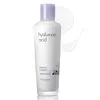What's inside
What's inside
 Key Ingredients
Key Ingredients

 Benefits
Benefits

 Concerns
Concerns

 Ingredients Side-by-side
Ingredients Side-by-side

Aloe Barbadensis Leaf Juice
Skin ConditioningButylene Glycol
HumectantEthyl Hexanediol
SolventSea Water
HumectantSodium Hyaluronate
HumectantPPG-26-Buteth-26
Skin ConditioningPEG-40 Hydrogenated Castor Oil
EmulsifyingCaprylyl Glycol
EmollientWater
Skin ConditioningPolyquaternium-51
Skin ConditioningPvm/Ma Copolymer
Emulsion StabilisingSodium Polyacrylate
AbsorbentAlcohol Denat.
AntimicrobialXanthan Gum
EmulsifyingPhenoxyethanol
PreservativeParfum
MaskingAlpha-Isomethyl Ionone
PerfumingButylphenyl Methylpropional
PerfumingHexyl Cinnamal
PerfumingLimonene
PerfumingLinalool
PerfumingAloe Barbadensis Leaf Juice, Butylene Glycol, Ethyl Hexanediol, Sea Water, Sodium Hyaluronate, PPG-26-Buteth-26, PEG-40 Hydrogenated Castor Oil, Caprylyl Glycol, Water, Polyquaternium-51, Pvm/Ma Copolymer, Sodium Polyacrylate, Alcohol Denat., Xanthan Gum, Phenoxyethanol, Parfum, Alpha-Isomethyl Ionone, Butylphenyl Methylpropional, Hexyl Cinnamal, Limonene, Linalool
Water
Skin ConditioningGlycerin
HumectantSodium Hyaluronate
HumectantDimethicone
EmollientButylene Glycol
HumectantCyclomethicone
EmollientDimethicone/Vinyl Dimethicone Crosspolymer
Skin ConditioningMalpighia Emarginata Fruit Extract
Skin ConditioningPEG-11 Methyl Ether Dimethicone
EmulsifyingPortulaca Oleracea Extract
Skin ConditioningVaccinium Angustifolium Fruit Extract
Skin ProtectingCarbomer
Emulsion StabilisingTriethanolamine
BufferingChlorphenesin
AntimicrobialCaprylyl Glycol
EmollientParfum
MaskingEthylhexylglycerin
Skin ConditioningC12-14 Pareth-12
EmulsifyingPanthenol
Skin ConditioningTocopheryl Acetate
AntioxidantDisodium EDTA
Hibiscus Sabdariffa Flower Extract
Skin ConditioningWater, Glycerin, Sodium Hyaluronate, Dimethicone, Butylene Glycol, Cyclomethicone, Dimethicone/Vinyl Dimethicone Crosspolymer, Malpighia Emarginata Fruit Extract, PEG-11 Methyl Ether Dimethicone, Portulaca Oleracea Extract, Vaccinium Angustifolium Fruit Extract, Carbomer, Triethanolamine, Chlorphenesin, Caprylyl Glycol, Parfum, Ethylhexylglycerin, C12-14 Pareth-12, Panthenol, Tocopheryl Acetate, Disodium EDTA, Hibiscus Sabdariffa Flower Extract
 Reviews
Reviews

Ingredients Explained
These ingredients are found in both products.
Ingredients higher up in an ingredient list are typically present in a larger amount.
Butylene Glycol (or BG) is used within cosmetic products for a few different reasons:
Overall, Butylene Glycol is a safe and well-rounded ingredient that works well with other ingredients.
Though this ingredient works well with most skin types, some people with sensitive skin may experience a reaction such as allergic rashes, closed comedones, or itchiness.
Learn more about Butylene GlycolCaprylyl Glycol is a humectant and emollient, meaning it attracts and preserves moisture.
It is a common ingredient in many products, especially those designed to hydrate skin. The primary benefits are retaining moisture, skin softening, and promoting a healthy skin barrier.
Though Caprylyl Glycol is an alcohol derived from fatty acids, it is not the kind that can dry out skin.
This ingredient is also used as a preservative to extend the life of products. It has slight antimicrobial properties.
Learn more about Caprylyl GlycolParfum is a catch-all term for an ingredient or more that is used to give a scent to products.
Also called "fragrance", this ingredient can be a blend of hundreds of chemicals or plant oils. This means every product with "fragrance" or "parfum" in the ingredients list is a different mixture.
For instance, Habanolide is a proprietary trade name for a specific aroma chemical. When used as a fragrance ingredient in cosmetics, most aroma chemicals fall under the broad labeling category of “FRAGRANCE” or “PARFUM” according to EU and US regulations.
The term 'parfum' or 'fragrance' is not regulated in many countries. In many cases, it is up to the brand to define this term.
For instance, many brands choose to label themselves as "fragrance-free" because they are not using synthetic fragrances. However, their products may still contain ingredients such as essential oils that are considered a fragrance by INCI standards.
One example is Calendula flower extract. Calendula is an essential oil that still imparts a scent or 'fragrance'.
Depending on the blend, the ingredients in the mixture can cause allergies and sensitivities on the skin. Some ingredients that are known EU allergens include linalool and citronellol.
Parfum can also be used to mask or cover an unpleasant scent.
The bottom line is: not all fragrances/parfum/ingredients are created equally. If you are worried about fragrances, we recommend taking a closer look at an ingredient. And of course, we always recommend speaking with a professional.
Learn more about ParfumSodium Hyaluronate is hyaluronic acid's salt form. It is commonly derived from the sodium salt of hyaluronic acid.
Like hyaluronic acid, it is great at holding water and acts as a humectant. This makes it a great skin hydrating ingredient.
Sodium Hyaluronate is naturally occurring in our bodies and is mostly found in eye fluid and joints.
These are some other common types of Hyaluronic Acid:
Learn more about Sodium HyaluronateWater. It's the most common cosmetic ingredient of all. You'll usually see it at the top of ingredient lists, meaning that it makes up the largest part of the product.
So why is it so popular? Water most often acts as a solvent - this means that it helps dissolve other ingredients into the formulation.
You'll also recognize water as that liquid we all need to stay alive. If you see this, drink a glass of water. Stay hydrated!
Learn more about Water